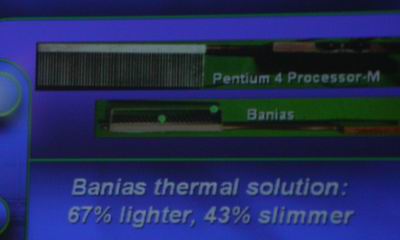Intel Developer Forum Fall 2002 - Day 2: Banias Galore
by Anand Lal Shimpi on September 10, 2002 2:12 PM EST- Posted in
- Trade Shows
Although there weren’t many details provided about these features, we did manage to get some clarity:
The Banias FSB is much more power optimized than any current Intel FSB; power management is achieved through turning off parts of the FSB that aren’t being used. When we talk about “turning off” a part of the FSB we’re really talking about turning off some of the power consuming buffers (memory) when they’re not in use.
We’ve already talked about Micro-Op Fusion, a feature that sends decoded instructions down the pipeline in bundles to improve efficiency. Another benefit of Micro-Op Fusion is reduced power usage because of a more efficient use of the pipeline. The Micro-Ops are only separated directly before being sent to the execution units.
Banias’ dedicated stack manager is another power saving tool integrated into the Banias architecture that is designed to manage stack pointers and other stack-related data. Remember that stacks are used to store information about the current state of the CPU including data that cannot be kept in registers due to limits in the number of available registers, thus a dedicated manager can help performance considerably. As usual, whenever efficiency is improved power consumption is optimized which is the case with Banias here as well.
Intel didn’t give much in terms of performance information on Banias however they did give us some clues to its positioning. Even after its release in the first half of next year, the Pentium 4-M will continue to exist alongside the Banias processor. The two processors will make up the two CPU market segments in the mobile market – Intel likes to call them the portability and mobility segments.

The Pentium 4-M reference heat exchanger

The Banias reference heat exchanger

Banias' heat exchanger is noticeably smaller than the Pentium 4-M's










0 Comments
View All Comments